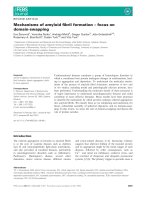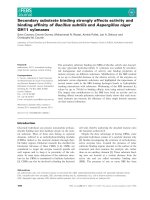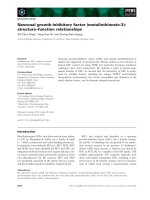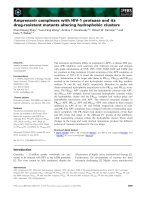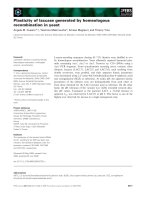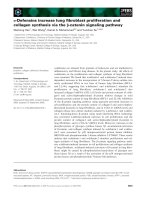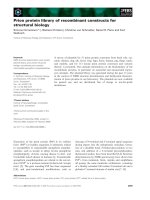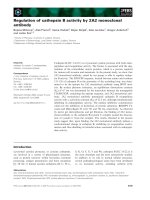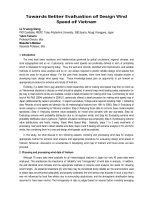Báo cáo khoa học: BRCA1 16 years later: nuclear import and export processes doc
Bạn đang xem bản rút gọn của tài liệu. Xem và tải ngay bản đầy đủ của tài liệu tại đây (190.65 KB, 7 trang )
MINIREVIEW
BRCA1 16 years later: nuclear import and export processes
Marilyn E. Thompson
Department of Pharmaceutical Sciences, School of Pharmacy, Belmont University, Nashville, TN, USA
Introduction
The importance of regulated nuclear transport pro-
cesses in modulating protein function has become
increasingly evident over the past several years.
Energy-dependent, receptor-mediated mechanisms are
required for proteins in excess of 40 kDa to cross the
nuclear envelope [1]. This suggests that in order for
many proteins to reside in their compartment of func-
tion, the nucleus, they must first be recognized by
import receptors, termed importins or karyopherins,
which effectuate the translocation of the cargo protein
across the membrane. Likewise, removal of the protein
from the nuclear compartment involves its binding to
nuclear export receptors (exportins). This translocation
event would preclude the functional activity of the
nuclear protein.
Breast cancer susceptibility gene 1 protein product
(BRCA1) is involved in multiple nuclear located func-
tions. At an apparent relative molecular mass of
approximately 220 kDa, it can only traverse the
nuclear envelope by an active process. However, in
more recent years, it has been realized that BRCA1
can also be exported from the nucleus as well. In this
Keywords
BRCA1-associated RING domain protein 1
(BARD1); breast cancer susceptibility gene 1
(BRCA1); nuclear export; nuclear export
sequence; nuclear import; nuclear
localization signal; RING finger
Correspondence
M. E. Thompson, Department of
Pharmaceutical Sciences, School of
Pharmacy, Belmont University, 1900
Belmont Blvd., Nashville, TN 37212, USA
Fax: +615 460 6537
Tel: +615 460 8121
E-mail:
Website: />pharmacy/
(Received 7 July 2009, revised 27 April
2010, accepted 26 May 2010)
doi:10.1111/j.1742-4658.2010.07733.x
Over the past several years, the importance of regulated nuclear transport
processes for tumor suppressors has become evident. Proteins with a
molecular mass greater than 40 kDa can enter the nucleus only by active
transport across the nuclear membrane. The most common pathway by
which this occurs is via the importin alpha ⁄ beta pathway, whereby the
cargo protein binds importin alpha. This heterodimer binds importin beta
and the heterotrimer passes through nuclear pores at the expense of GTP.
Breast cancer susceptibility gene 1 (BRCA1) is one such protein. As a
mediator of transcription and DNA repair, two exclusively nuclear func-
tions, BRCA1, at 220 kDa, can enter the nucleus only via active transport
mechanisms. In addition to the classical importin alpha ⁄ beta pathway,
BRCA1 can also enter the nucleus in a piggyback mechanism with
BRCA1-associated RING domain protein 1 (BARD1). The interaction
between BRCA1 and BARD1 is also important in the retention of BRCA1
in the nucleus. This is important because BRCA1 also undergoes active
nuclear export. BRCA1 is also involved in apoptotic processes. Whether
this occurs within the nucleus or cytoplasm is still unclear; thus, the conse-
quences of BRCA1 nuclear export have not been clearly elucidated. This
review will discuss the literature regarding the subcellular localization
of BRCA1, with particular emphasis on its nuclear import and export
processes.
Abbreviations
BARD1, BRCA1-associated RING domain protein 1; BRCA1, breast cancer susceptibility gene 1; NLS, nuclear localization signal; TRAIL,
tumor necrosis factor apoptosis inducing ligand.
3072 FEBS Journal 277 (2010) 3072–3078 ª 2010 The Author Journal compilation ª 2010 FEBS
review, the literature regarding BRCA1 nuclear import
and export with potential functional implications of
these processes will be discussed.
Historical overview of cellular
localization of BRCA1
BRCA1 was first identified and sequenced in 1994. At
that time, the only notable structural feature of the
protein documented was a C3HC4 sequence at its
amino terminus. This was recognized as a zinc finger
domain, which is common to many transcription fac-
tors [2]. This suggested that BRCA1 served in this
capacity and led to the assumption that BRCA1 was a
nuclear protein. In support of this assumption, several
laboratories reported the nuclear localization of
BRCA1. Scully et al. [3] indicated that BRCA1 was
present predominantly within the nucleus of a variety
of breast and ovarian tumor-derived cell lines. This
countered an earlier report by Chen et al. [4], who sug-
gested that BRCA1 was indeed localized to the nucleus
in nonmalignant cells; however, in the tumor cell lines
examined by this group, BRCA1 was concluded to
aberrantly localize within the cytoplasm. Many locali-
zation studies [5–8] subsequent to these continued to
implicate BRCA1, as well as its variants, as nuclear
proteins.
For example, Thomas et al. [6] demonstrated by
both immunofluorescence and biochemical fraction-
ation techniques that in some breast, ovarian and cer-
vical cancer cell lines, BRCA1 was vastly nuclear.
Immunoblot analysis of subcellular fractions from two
breast cancer cell lines, MDA-MB-469 and MCF-7,
did indicate the presence of BRCA1 in the cytoplasm.
However, the cytoplasmic levels were substantially less
than in the nucleus. Whether the presence of BRCA1
in the cytoplasm was attributable to newly translated
protein prior to being transported into the nucleus or
due to another molecular event was not addressed.
Rather, this study substantiated the report by Scully
et al. [3] that regardless of the malignant state of
the cells, the proportion of BRCA1 localizing to
the nucleus was much higher than that outside the
nucleus.
The discrepancies in the literature regarding the
nuclear ⁄ non-nuclear distribution of BRCA1 in malig-
nant cells generated much concern and discussion over
the validity of the data. Perhaps the most significant
contribution towards resolving this cause ce
´
le
`
bre was
provided by Wilson et al. [5]. In an exhaustive analysis
of 19 different BRCA1 IgGs generated against various
epitopes, this group demonstrated that the presence of
a BRCA1 signal outside the nucleus could be the result
of experimental artifact. Analysis of the antibodies for
their utility in recognizing BRCA1 via immunoprecipi-
tations, immunoblotting, immunohistochemistry and
immunocytochemistry revealed that certain variables,
such as antibody concentration and method of fixation,
influenced the detection of a signal. This highly cited
paper was instrumental in reconciling that BRCA1 was
predominantly localized to the nucleus in both malig-
nant and nonmalignant cells.
In 1997, the Rao laboratory [8] first indicated a reg-
ulatory aspect to BRCA1 nuclear ⁄ non-nuclear distri-
bution. Prior to this, Scully et al. [9] had proposed
that the intranuclear localization of BRCA1 was influ-
enced by the cell cycle-dependent phosphorylation
state of the protein. However, this dictated whether or
not BRCA1 localized into nuclear foci or not within
the nucleus and did not address the non-nuclear pres-
ence of BRCA1. The Rao laboratory suggested that
BRCA1 nuclear ⁄ non-nuclear distribution could be
dictated by the presence of serum growth factors.
Although they did not attribute this to phosphoryla-
tion per se, their report did suggest that BRCA1 did
not spontaneously traverse the nuclear envelope.
Nuclear import of BRCA1
Although it was appreciated early after the identifica-
tion of its gene that BRCA1 was a predominantly
nuclear protein, the mechanism of its import into the
nucleus was not described until 1997. Two reports doc-
umenting BRCA1 nuclear import were published
within a short time of each other. First, Thakur et al.
[10] compared the subcellular localization of full-length
BRCA1 with that of a BRCA1 variant lacking exon
11, resulting in the expression of a 97 kDa protein.
This comparison demonstrated the presence of a
nuclear localization signal (NLS) within this exon as
the variant was unable to localize to the nucleus as the
wild-type could. Considering potential changes in the
secondary and tertiary structures of the protein result-
ing from the loss of half of the amino acids, the
authors were able to demonstrate it was the loss of a
distinct sequence that precluded the variant from
entering the nucleus. Two NLSs were identified at
amino acid residues 501–507 (KCKRKRR; referred to
as NLS1) and 607–614 (KKNRLRRK; referred to as
NLS2). Both sequences are located within exon 11, the
largest of the exons in BRCA1 (Fig. 1). Deletion muta-
genesis demonstrated that only the sequence between
residues 501 and 507 was vital for BRCA1 nuclear
import.
Although these data indicated that BRCA1 entered
the nucleus via a basic arginine-lysine-rich nuclear
M. E. Thompson BRCA1 nuclear import and export
FEBS Journal 277 (2010) 3072–3078 ª 2010 The Author Journal compilation ª 2010 FEBS 3073
localization sequence; they did not clearly demonstrate
interaction with import machinery. Chen et al. [11]
carried the work to the next step and demonstrated
the interaction of NLS1 (amino acids 501–508) with
importin alpha. This clearly marked BRCA1 as a pro-
tein that enters the nucleus via the classical importin
alpha ⁄ beta pathway (Fig. 2).
An alternative nuclear import pathway
for BRCA1
Although BRCA1 does interact with importin alpha to
be actively transported across the nuclear envelope,
Wang et al. [8] observed that splice variants lacking
exon 11, where both NLS are located, could also be
RING finger
domain (aa 1–109)
Transcriptional activation domain
(aa 1560–1863)
1
1863
Nuclear export sequences
(aa 22–39 and aa 81–99)
Nuclear localization signals
(aa 503–508 and aa 607–614)
BRCT domains
(aa 1640–1729 and aa 1760–1821)
Fig. 1. Schematic of key structural ⁄
functional elements of BRCA1. Nuclear
targeting sequences of BRCA1 are shown
in relationship to the RING finger domain,
BRCA1 C Terminus (BRCT) and
transcriptional activation domains.
BRCA1
α
β
BRCA1
α
β
BRCA1
α
β
BRCA1
α
β
BRCA1
α
BRCA1
α
β
α
α
BRCA1
BARD 1
BRCA1
BARD 1
α
β
β
BRCA1
BARD 1
α
β
BRCA1
BARD 1
α
β
BRCA1
BARD 1
α
1
2
3
4
5
6
i
ii
iii
iv
v
vi
Extracellular
Cytoplasm
Nucleus
Fig. 2. Schematic representing the two mechanisms for BRCA1 nuclear import. The depiction on the left represents BRCA1 binding directly
to the import machinery. (1) BRCA1 binds importin alpha, which subsequently (2) binds importin beta. (3) The heterotrimer crosses the
nuclear envelope in a GTP-dependent manner (hydrolysis of GTP to GDP not shown). Inside the nucleus, the trimer dissociates (4, 5) and
importin alpha and beta are exported from the nucleus (6) to be used again. The depiction on the right side represents BRCA1 binding to
BARD in order to enter the nucleus. The BARD1:BRCA1 complex binds to the import machinery by first binding to importin alpha (i). The
BRCA1:BARD1:importin alpha complex binds importin beta (ii). This complex enters the nucleus in an energy-dependent manner (iii). Inside
the nucleus, importins beta (iv) and alpha (v) dissociate from the BARD1:BRCA1 complex and are recycled.
BRCA1 nuclear import and export M. E. Thompson
3074 FEBS Journal 277 (2010) 3072–3078 ª 2010 The Author Journal compilation ª 2010 FEBS
found in the nucleus. This led to the supposition that
there was an alternative pathway by which BRCA1
entered the nucleus. Fabbro et al. [12] reported that
the non-NLS-dependent mechanism for BRCA1 locali-
zation to the nucleus required its RING finger domain.
Furthermore, the extent of nuclear localization of the
variants correlated with the level of BRCA1-associated
RING domain protein 1 (BARD1) expression. Given
that BRCA1 and BARD1 bind via their RING finger
domains, it was postulated that BRCA1 can enter the
nucleus in a piggyback mechanism with BARD1.
With the demonstration of two independent mecha-
nisms for BRCA1 nuclear import, studies turned to
investigating potential regulation of this translocation
event. It had already been proposed that phosphoryla-
tion, potentially due to the presence of serum growth
factors, modulated BRCA1 localization, although no
specific phosphoacceptor sites were initially identified.
However, in 1999, Altiok et al. [13] published that the
administration of heregulin b1 to T47D human breast
cancer cells resulted in Akt-mediated phosphorylation
of BRCA1 on serine 508, a site adjacent to NLS1.
However, no functional consequences of this phos-
phorylation were determined. Hinton et al. [14] subse-
quently demonstrated that the exposure of cells to the
growth factor resulted in an increase in nuclear accu-
mulation of BRCA1. The cells were serum starved
prior to the administration of heregulin. Interestingly,
these conditions resulted in much of the BRCA1 local-
izing outside the nucleus, in contrast to the observa-
tions of Wang et al. [8], who reported that in the
absence of serum, NIH3T3 fibroblasts, Hs578BST,
HBL-100, ZR75-1, CAMA breast tumor cells and
NIH OVCAR3 ovarian cancer cells exhibited a mostly
nuclear presence of BRCA1, which redistributed to the
cytoplasm upon serum addition.
The far-reaching biological implications of Akt-med-
iated regulation of BRCA1 are not understood. The
ability of Akt to enhance the nuclear presence of
BRCA1 superficially seems to be dichotomous.
BRCA1 has many tumor suppressive associated func-
tions within the nucleus. Thus, it would be confound-
ing for Akt, a cell survival kinase, to facilitate its
nuclear presence. However, numerous reports docu-
ment a role for BRCA1 in apoptosis. Some of these
data suggest that this function is mediated through
cytoplasmic BRCA1. Indeed, several reports have doc-
umented an association of BRCA1 with the cytoplas-
mic enzyme, acetyl CoA carboxylase [15–17]. This
interaction, which is mediated through the BRCA1 C
Terminus domains of BRCA1, regulated lipogenesis in
mammary epithelial cell lines. Specifically, BRCA1
interacted with the phosphorylated, inactive form of
acetyl CoA carboxylase and interfered with its dephos-
phorylation [16]. The decrease in functional, dephos-
phorylated acetyl CoA carboxylase resulted in limited
synthesis of palmitic acid and this led to apoptosis
[17,18]. Also, noteworthy is the work of Dizin et al.
[19], who demonstrated that cytoplasmic BRCA1 is
proteolytically processed into a 90 kDa fragment that
exhibits the apoptotic activity of the protein. These
results may explain the otherwise confounding scenario
of Akt-mediated nuclear accumulation of BRCA1.
Other factors shown to regulate BRCA1 localization
include hypoxia and tumor necrosis factor apoptosis
inducing ligand (TRAIL). Fitzgerald et al. [20] demon-
strated that exposure of several malignant mammary
cell lines to hypoxia resulted in an enhancement of
nuclear BRCA1, with concomitant decreases in cyto-
plasmic levels. Although earlier reports had suggested
that hypoxia decreased BRCA1 expression [21,22], this
was not evident under the conditions used by Fitzger-
ald et al. [20]. Additionally, this effect was not
observed in nonmalignant cells, but was mimicked by
the administration of TRAIL to the cells. The expres-
sion of BRCA1 facilitated TRAIL-induced apoptosis.
The idea that TRAIL induction of apoptosis is
enhanced by nuclear BRCA1 would suggest that under
those conditions it is nuclear BRCA1 that augments
apoptosis. One plausible mechanism by which this may
occur is that BRCA1 could be transactivating genes
involved in the apoptotic process. However, this
hypothesis has yet to be tested.
Nuclear export of BRCA1
The nuclear ⁄ non-nuclear distribution of BRCA1 has
been reported by numerous laboratories. This includes
several reports of BRCA1 association with microtubules
and centrosomes. However, the non-nuclear presence of
BRCA1 was not specifically addressed until 2000, when
Rodriguez & Henderson [23] published that BRCA1
underwent receptor-mediated nuclear export. These
investigators delineated amino acid residues 81–99 as a
Rev-like nuclear export sequence. This type sequence,
which binds to CRM1 nuclear export receptor to facili-
tate translocation of the cargo protein across the
nuclear membrane at the expense of GTP, is defined by
a characteristic pattern of hydrophobic amino acids.
The consensus sequence is L-X
1-3
-L-X
2-4
-L-X-L. In
addition to the presence of this motif at residues 81–99,
BRCA1 has three other regions (amino acids 22–30,
591–600, 783–793) that also fit the consensus sequence.
Of these, only residues 22–30 have been shown to have
functional nuclear export activity [24]. The presence of
two distinct nuclear export sequences is not novel. Other
M. E. Thompson BRCA1 nuclear import and export
FEBS Journal 277 (2010) 3072–3078 ª 2010 The Author Journal compilation ª 2010 FEBS 3075
tumor suppressors, including p53 [25,26], also have mul-
tiple functional nuclear export sequences.
Few reports have documented a regulatory compo-
nent to BRCA1 nuclear export [12,27–30]. Fabbro
et al. [12] suggested that the interaction of BRCA1
with BARD1 resulted in inhibition of BRCA1 nuclear
export. Comparing the localization of wild-type
BRCA1 with BRCA1 mutant construct in which the
amino terminal nuclear export sequence at amino acids
81–99 was transferred to the carboxy terminus, this
group showed that co-expression of BARD1 resulted
in nuclear accumulation of wild-type BRCA1, but had
no inhibitory effect on the nuclear export of the
mutant. The authors concluded that BARD1 masks
the amino terminal BRCA1 nuclear export sequence
and, therefore, export could be regulated by BARD1
expression. Thus, BARD1 is important for both the
nuclear import and nuclear retention of BRCA1.
This laboratory subsequently assigned a physiologi-
cal relevance to BARD1-mediated nuclear retention of
BRCA1. Data support the idea that nuclear retention
of BRCA1 decreases BRCA1-dependent apoptosis
[27]. The data indicating that the recovery of BRCA1
nuclear export support those of others who have sug-
gested that the apoptotic function of BRCA1 is due to
its cytoplasmic localization.
Another study revealing a novel regulatory event for
BRCA1 nuclear export was reported by Glover-Collins
& Thompson [28]. In this report, the authors were able
to demonstrate that nuclear export of BRCA1
occurred in a cell cycle-dependent manner, resulting in
BRCA1 transiently concentrating in a perinuclear loca-
tion during the early part of S phase. This relocation
was blocked by the introduction of the calcium chela-
tor, BAPTA-AM, and was mimicked by the calcium
ionophore, A23187. The biological relevance of this
calcium-dependent modulation is not yet understood.
However, progression of the mammalian cell cycle has
been shown to be dependent on calcium signaling and
a calcium transient occurs at the G1 ⁄ S boundary [29].
These findings may suggest that the transient nuclear
export of BRCA1 during early S phase is a conse-
quence of the G1 ⁄ S calcium peak.
Conclusion
In this review we have discussed one aspect of BRCA1
regulation – its nuclear to non-nuclear distribution.
BRCA1 is one of many tumor suppressors that
undergo active nuclear import and export processes
(see Table 1 for targeting sequences). It would seem
almost wasteful to expend the energy for opposing
transport mechanisms. However, the dynamic equilib-
rium between BRCA1 nuclear import and export could
provide a fine level of regulation of its nuclear and⁄ or
cytoplasmic functions.
Tight regulatory control of BRCA1 localization has
far-reaching implications. Numerous mutations with
different functional classifications have been docu-
mented in BRCA1 [31]. Several reported patient muta-
tions probably affect either the nuclear import or export
of BRCA1 and result in a disturbance of the nuclear to
non-nuclear distribution and function. Pharmacologi-
cally, this could potentially be exploited. Data suggest
that histone deacetylase [32] and poly ADP ribose poly-
merase [33,34] inhibitors are more effective in patients
who are BRCA1 negative. Theoretically, if BRCA1
localization can be pharmacologically manipulated to
render it nonfunctional, the use of histone deacetylase
and poly ADP ribose polymerase inhibitors could bene-
fit a broader range of patients. However, the lack of
specificity in manipulating BRCA1 in malignant, but
not nonmalignant, cells, would certainly present a chal-
lenge for the clinical usefulness of this approach. How-
ever, with technological advances, such as the
development of nanoparticles to deliver drugs specifi-
cally to cancer cells [35], future use of this therapeutic
regimen does not necessarily have to be ruled out.
References
1 Terry LJ, Shows EB & Wente SR (2007) Crossing the
nuclear envelope: hierarchical regulation of nucleocyto-
plasmic transport. Science 318, 1412–1416.
2 Miki Y, Swensen J, Shattuck-Eidens D, Futreal PA,
Harshman K, Tavtigian S, Liu Q, Cochran C, Bennett
LM, Ding W et al. (1994) A strong candidate for the
breast and ovarian cancer susceptibility gene BRCA1.
Science 266, 66–71.
3 Scully R, Ganesan S, Brown M, De Caprio JA, Cannis-
tra SA, Feunteun J, Schnitt S & Livingston DM (1996)
Location of BRCA1 in human breast and ovarian can-
cer cells. Science 272, 123–125.
4 Chen Y, Chen CF, Riley DJ, Allred DC, Chen PL, Von
Hoff D, Osborne CK & Lee WH (1995) Aberrant sub-
cellular localization of BRCA1 in breast cancer. Science
270, 789–791.
Table 1. BRCA1 nuclear targeting sequences.
NLSs
Basic monopartite NLS KKKRK
BRCA1 amino acids 501–508 KLKRKRRP
BRCA1 amino acids 607–614 KKNRLRRK
Nuclear export sequences
Consensus LX
1-3
LX
2-4
LXL
BRCA1 amino acids 22–30 LECPICLEL
BRCA1 amino acids 81–99 QLVEELLKIICAFQLDTGL
BRCA1 nuclear import and export M. E. Thompson
3076 FEBS Journal 277 (2010) 3072–3078 ª 2010 The Author Journal compilation ª 2010 FEBS
5 Wilson CA, Ramos L, Villasenor MR, Anders KH,
Press MF, Clarke K, Karlan B, Chen JJ, Scully R,
Livingston D et al. (1999) Localization of human
BRCA1 and its loss in high-grade, non-inherited breast
carcinomas. Nat Genet 21, 236–240.
6 Thomas JE, Smith M, Rubinfeld B, Gutowski M,
Beckmann RP & Polakis P (1996) Subcellular localiza-
tion and analysis of apparent 180-kDa and 220-kDa
proteins of the breast cancer susceptibility gene,
BRCA1. J Biol Chem 271, 28630–28635.
7 Maul GG, Jensen DE, Ishov AM, Herlyn M & Rauscher
FJ III (1998) Nuclear redistribution of BRCA1 during
viral infection. Cell Growth Differ 9, 743–755.
8 Wang H, Shao N, Ding QM, Cui J, Shyam E, Reddy P
& Rao VN (1997) BRCA1 proteins are transported to
the nucleus in the absence of serum and splice variants
BRCA1a, BRCA1b are tyrosine phsophoproteins that
associate with E2F, cyclins and cyclin dependent
kinases. Oncogene 15, 143–157.
9 Scully R, Chen J, Ochs RL, Keegan K, Hoekstra M,
Feunteun J & Livingston DM (1997) Dynamic
changes of BRCA1 subnuclear location and phosphor-
ylation state are initiated by DNA damage. Cell 90,
425–435.
10 Thakur S, Zhang HB, Peng Y, Le H, Carroll B, Ward
T, Yao J, Farid LM, Couch FJ, Wilson RB et al.
(1997) Localization of BRCA1 and a splice variant
identifies the nuclear localization signal. Mol Cell Biol
17, 444–452.
11 Chen C-F, Li S, Chen Y, Chen P-L, Sharp ZD & Lee
W-H (1996) The nuclear localization sequences of the
BRCA1 protein interact with the importin-alpha sub-
unit of the nuclear transport signal receptor. J Biol
Chem 271, 32863–32868.
12 Fabbro M, Rodriguez JA, Baer R & Henderson BR
(2002) BARD1 induces BRCA1 intranuclear foci forma-
tion by increasing RING-dependent BRCA1 nuclear
import and inhibiting BRCA1 nuclear export. J Biol
Chem 277, 21315–21324.
13 Altiok S, Batt D, Altiok N, Papautsky A, Downward J,
Roberts TM & Avraham H (1999) Heregulin induces
phosphorylation of BRCA1 through phosphatidylinosi-
tol 3-kinase ⁄ AKT in breast cancer cells. J Biol Chem
274, 32274–32278.
14 Hinton CV, Fitzgerald LD & Thompson ME (2007)
Phosphatidylinositol 3-kinase ⁄ Akt signaling enhances
nuclear localization and transcriptional activity of
BRCA1. Exp Cell Res 313, 1735–1744.
15 Magnard C, Bachelier R, Vincent A, Jaquinod M,
Kieffer S, Lenoir GM & Venezia ND (2002) BRCA1
interacts with acetyl-CoA carboxylase through its
tandem of BRCT domains. Oncogene 21, 6729–6739.
16 Moreau K, Dizen E, Ray H, Luquain C, Lefai E,
Foufelle F, Billaud M, Lenoir GM & Venezia ND
(2006) BRCA1 affects lipid synthesis through its
interaction with acetyl CoA carboxylase. J Biol Chem
281, 3172–3181.
17 Chajes V, Cambot M, Moreau K, Lenoir GM & Joulin
V (2006) Acetyl-CoA carboxylase a is essential to breast
cancer cell survival. Cancer Res 66 , 5287–5294.
18 Beckers A, Organe S, Timmermans L, Scheys K,
Peeters A, Brusselmans K, Verhoeven G & Swinnen JV
(2007) Chemical inhibition of acetyl-CoA carboxylase
induces growth arrest and cytotoxicity selectively in
cancer cells. Cancer Res 67, 8180–8187.
19 Dizin E, Ray H, Suau F, Voeltzel T & Venezia ND
(2008) Caspase-dependent BRCA1 cleavage facilitates
chemotherapy-induced apoptosis. Apoptosis 12, 237–
246.
20 Fitzgerald LD, Bailey CK, Brandt S & Thompson ME
(2007) BRCA1 accumulates in the nucleus in response to
hypoxia and TRAIL and enhances TRAIL-induced
apoptosis in breast cancer cells.
FEBS J 274, 5137–5146.
21 Meng AX, Jalali F, Cuddihy A, Chan N, Bindra RS,
Glazer PM & Bristow RG (2005) Hypoxia down-
regulates DNA double strand break repair gene
expression in prostate cancer cells. Radiother Oncol
76, 168–176.
22 Bindra RS, Gibson SL, Meng A, Westermark U, Jasin
M, Pierce AJ, Bristow RG, Classon MK & Glazer PM
(2005) Hypoxia-induced down-regulation of BRCA1
expression by E2Fs. Cancer Res 65, 11597–11604.
23 Rodriguez JA & Henderson BR (2000) Identification of
a functional nuclear export sequence in BRCA1. J Biol
Chem 275, 38589–38596.
24 Thompson ME, Robinson-Benion CL & Holt JT (2005)
An amino-terminal motif functions as a second nuclear
export sequence in BRCA1. J Biol Chem 280, 21854–
21857.
25 Stommell JM, Marchenko ND, Jimenez GS, Moll UM,
Hope TJ & Wahl GM (1999) A leucine-rich nuclear
export signal in the p53 tetramerization domain: regula-
tion of subcellular localization and p53 activity by NES
masking. EMBO J 18, 1660–1672.
26 Zhang Y & Xiong Y (2001) A p53 amino-terminal
nuclear export signal inhibited by DNA damage-
induced phosphorylation. Science 292, 1910–1915.
27 Fabbro M, Schuechner S, Au WWY & Henderson BR
(2004) BARD1 regulates BRCA1 apoptotic function by
a mechanism involving nuclear retention. Exp Cell Res
298, 661–673.
28 Glover-Collins K & Thompson ME (2008) Nuclear
export of BRCA1 occurs during early S phase and is
calcium-dependent. Cell Signal 20, 958–968.
29 Kahl CR & Means AR (2003) Regulation of cell cycle
progression by calcium ⁄ calmodulin-dependent path-
ways. Endocr Rev 24, 719–736.
30 Yang ES & Xia F (2010) BRCA1 16 years later: DNA
damage-induced BRCA1 shuttling. FEBS J 277, 3079–
3085.
M. E. Thompson BRCA1 nuclear import and export
FEBS Journal 277 (2010) 3072–3078 ª 2010 The Author Journal compilation ª 2010 FEBS 3077
31 Linger RJ & Kruk PA (2010) BRCA1 16 years later:
risk-associated BRCA1 mutations and their functional
implications. FEBS J 277, 3086–3096.
32 Zhang Y, Carr T, Dimtchev A, Zaer N, Dritschilo A &
Jung M (2007) Attenuated DNA damage repair by tri-
chostatin A through BRCA1 suppression. Radiat Res
168, 115–124.
33 Rottenberg S, Jasper JE, Kersbergen A, van der Burg
E, Nygren AO, Zander SA, Derksen PW, de Bruin M,
Zevenhoven J, Lau A et al. (2008) High sensitivity of
BRCA1-deficient mammary tumors to the PARP
inhibitor AZD2281 alone and in combination with
platinum drugs. Proc Natl Acad Sci USA 105,
17079–17084.
34 Fong PC, Boss DS, Yap TA, Tutt A, Wu P, Mergui-
Roelvink M, Mortimer P, Swaisland H, Lau A, O’Con-
nor MJ et al. (2009) Inhibition of poly (ADP-ribose)
polymerase in tumors from BRCA1 mutation carriers.
N Engl J Med 361, 123–134.
35 Xu C, Wang B & Sun S (2009) Dumbbell-like Au-
Fe3O4 nanoparticles for target-specific platin delivery.
J Am Chem Soc 131, 4216–4217.
BRCA1 nuclear import and export M. E. Thompson
3078 FEBS Journal 277 (2010) 3072–3078 ª 2010 The Author Journal compilation ª 2010 FEBS
